____ DNA technology uses in vitro molecular techniques that combine DNA fragments to produce novel arrangements.
Recombinant
A molecule that has covalently linked DNA fragments from at least two sources is called a ____ ____ molecule.
recombinant DNA
Making many copies of a particular DNA segment using vectors or the polymerase chain reaction is called gene
cloning
You would ____ a gene to make many copies of that gene.
Blank 1: clone or amplify
Which of the following is pharmaceutical product that is produced by bacteria expressing the human gene?
Multiple choice question.
Insulin
Simvastatin
Oxycodone
Aspirin
Insulin
What is recombinant DNA technology?
Multiple choice question.
The only way to cure disease
The production of new arrangements of DNA
Double-stranded breaks in chromosomes
The control of expression of bacterial genes
The production of new arrangements of DNA
A particular gene to be cloned is often isolated from ______.
Multiple choice question.
bacterial DNA only
in vitro constructed DNA
chromosomal DNA
RNA
chromosomal DNA
A recombinant DNA molecule has covalently linked DNA fragments from ______.
Multiple choice question.
bacteria and viruses
genes that encode protein and pseudogenes
at least two different sources
bacteria and humans only
at least two different sources
What is a cloning vector?
Multiple choice question.
A molecule that carries the DNA to be cloned
A large DNA molecule with many genes
A molecule that creates mutations in DNA segments
A cell from the Domain Archaea
A molecule that carries the DNA to be cloned
The replication of recombinant DNA molecules inside a host cell is one form of ______.
Multiple choice question.
DNA sequencing
mutagenesis
gene cloning
Northern blotting
gene cloning
What is the term that describes a cell that contains a DNA cloning vector?
Multiple choice question.
Site-directed mutant
Vectorized cell
Bacteriophage
Host cell
Host cell
What is the purpose of gene cloning?
Multiple choice question.
To determine what vectors are plasmids
To analyze DNA binding proteins
To track the inheritance of an allele
To produce many copies of a DNA molecule of interest
To produce many copies of a DNA molecule of interest
A small circular DNA molecule that is often used as a vector in gene cloning is called a(n)
plasmid
Select all that apply
Which of the following are common uses of gene cloning?
Multiple select question.
The expression of a cloned gene can be used to discover its cellular function.
Cloned genes can be introduced into bacteria to make medicines.
Cloned genes are always used in forensic investigations.
Cloned genes can be used in trials of gene therapy.
The expression of a cloned gene can be used to discover its cellular function.
Cloned genes can be introduced into bacteria to make medicines.
Cloned genes can be used in trials of gene therapy.
Naturally occurring plasmids that confer resistance to antibiotics are called
Blank 1: R
Blank 2: plasmids, factors, or factor
True or false: Chromosomal DNA is a common source of cloned DNA.
True
Reason:
Although any DNA can be cloned, it is convenient to separate the gene of interest from the chromosomal DNA.
A vector requires an origin of replication so that it can be ______.
Multiple choice question.
analyzed through DNA sequencing
altered by the host cell
used to express proteins
copied many times by the host cell
copied many times by the host cell
A DNA molecule that acts as a carrier of DNA that is to be cloned is called a(n) ______.
Multiple choice question.
cloning vector
initiation complex
transfer RNA
selectable marker
cloning vector
A cell that harbors a vector is called a
host cell
Which sequence determines whether or not a vector can replicate in a particular cell?
Multiple choice question.
The origin of replication
The translation start site
The antibiotic resistance site
An Eco RI restriction site
The origin of replication
What is a plasmid?
Multiple choice question.
A gene for a selectable marker, such as antibiotic resistance
A small circular DNA molecule often used as a vector in gene cloning
A virus that is missing several genes and is often used as a vector in gene cloning
A large linear DNA molecule with an origin of replication
A small circular DNA molecule often used as a vector in gene cloning
A vector must contain the ____ ____ that is recognized by the species of the host cell and allows the host cell to make lots of copies of the vector.
origin of replication
R factors make useful vectors because they ______.
Multiple choice question.
confer resistance to antibiotics
can accept chromosomal DNA
do not contain an origin of replication
are especially small
confer resistance to antibiotics
Why would one use a vector with a selectable marker?
Multiple choice question.
To identify protein-binding DNA sequences
To identify cells containing the vector
To create site-directed mutants
To allow the enzymes of the host cell to replicate the vector
To identify cells containing the vector
Reason:
Genes for enzymes that replicate the vector are on the host cell chromosome.
What do you call the DNA sequence in a vector that allows the replication enzymes of the cell to make lots of copies of the vector?
Multiple choice question.
Antibiotic resistance gene
Promoter and operator
Origin of replication
Selectable marker
Origin of replication
True or false: Viruses cannot be used as vectors in gene cloning.
False
Reason:
Viruses can be used as vectors, typically to carry small pieces of DNA.
What is a cloning vector?
Multiple choice question.
A cell from the Domain Archaea
A molecule that creates mutations in DNA segments
A large DNA molecule with many genes
A molecule that carries the DNA to be cloned
A molecule that carries the DNA to be cloned
Which of the following vectors would you use to clone a large piece of DNA?
Multiple choice question.
R plasmid
Host cell
Cosmid
Virus
Cosmid
Reason:
Viruses are commonly used to clone small segments of DNA.
The sequence of the ____ of ____ determines whether or not a vector can replicate in a particular type of host cell.
Blank 1: origin
Blank 2: replication
Enzymes that bind to a specific DNA sequence and cut the DNA backbone are called
Blank 1: restriction
Blank 2: endonucleases or enzymes
In gene cloning, how is a suitable vector chosen?
Multiple choice question.
It must be a very specific size
It must contain 3 or more antibiotic resistance genes
It must replicate in only one cell type
It must replicate in the appropriate cell type
It must replicate in the appropriate cell type
Many species of bacterial cells make restriction enzymes to protect themselves from invasion by
Blank 1: bacteriophages, viruses, DNA, or phages
A resistance gene that allows a host cell containing a vector to grow on a toxic substance is called a(n)
selectable marker
Viruses can be used as ____ to carry other pieces of DNA.
vectors
"Sticky ends" created by cutting DNA with a restriction enzyme are useful in cloning because they ______.
Multiple choice question.
allow the identification of host cells containing vectors
are only created in vector DNA
are important in producing RNA
are areas where two pieces of DNA can hydrogen bond
are areas where two pieces of DNA can hydrogen bond
Reason:
Genetic markers are used to identify host cells that contain vectors.
Select all that apply
Select all vectors that can be used to clone large segments of DNA.
Multiple select question.
BACs
Plasmids
Cosmids
YACs
BACs
Cosmids
YACs
When cloning a gene into a vector, the sugar-phosphate backbone of each DNA molecule is covalently linked by the enzyme DNA
ligase
Restriction endonucleases are used in gene cloning to ______.
Multiple choice question.
cut the DNA backbone and reveal protein-binding sequences
create site-directed mutants
cut the DNA backbone prior to inserting the DNA to be cloned
identify host cells containing vectors
cut the DNA backbone prior to inserting the DNA to be cloned
Reason:
There are other protein-binding sequences besides the ones recognized by restriction enzymes.
Fill in the blank question.
A DNA sequence in one strand that is identical when read in the opposite direction in the other strand is called a ____ sequence.
palindromic
How does a bacterial cell use restriction enzymes?
Multiple choice question.
To determine the nucleotide sequence of the cloned DNA
To help the replication enzymes make many copies of the vector
To protect the cell against engulfment by a white blood cell
To protect the cell against invasion by bacteriophages
To protect the cell against invasion by bacteriophages
Select the sequence that is palindromic.
Multiple choice question.
5'-AAGGAA-3' 3'-TTCCTT-5'
5'-CCACCA-3' 3'-GGTGGT-5'
5'-GGATCC-3' 3'-CCTAGG-5'
5'-GGATCC-3' 3'-CCTAGG-5'

Single-stranded stretches of DNA created by restriction enzymes, such as those shown on the left and right sides of the molecule in the figure, are called
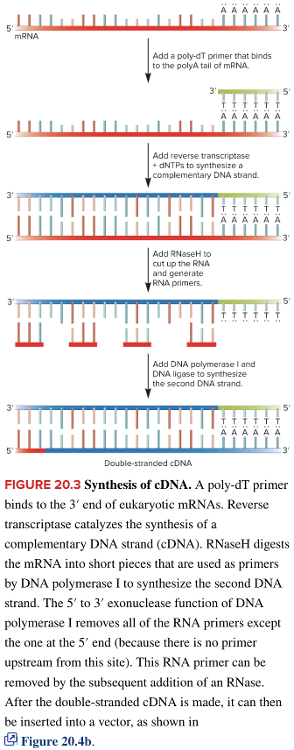
sticky ends
Click and drag on elements in order
Order the following steps in cloning a gene, putting the first step at the top.
The digested chromosomal DNA and plasmid DNA are incubated together.
Ligation by DNA ligase.
Chromosomal DNA is isolated and cut with a restriction enzyme; the plasmid DNA is cut with the same enzyme.
1. Chromosomal DNA is isolated and cut with a restriction enzyme; the
plasmid DNA is cut with the same enzyme.
2. The digested
chromosomal DNA and plasmid DNA are incubated together.
3.
Ligation by DNA ligase.
What does the enzyme DNA ligase do?
Multiple choice question.
It cuts the DNA backbone at a specific sequence.
It binds to DNA and prevents other enzymes from cutting the backbone.
It covalently links the sugar-phosphate backbone of DNA.
It binds to DNA and prevents RNA polymerase form binding.
It covalently links the sugar-phosphate backbone of DNA.
A recombinant vector ______.
Multiple choice question.
has ligated back to its original form
never contains foreign DNA
contains a piece of chromosomal DNA
always has the same restriction sites
contains a piece of chromosomal DNA
Restriction enzymes usually recognize ____ sequences in which the sequence in one strand is identical to the complementary strand read in the opposite direction.
palindromic
If the two ends of a vector cut with a restriction enzyme ligate back together without an insert, a ____ vector has been created.
recircularized
Cells that can take up DNA from the medium are considered ____ cells.
competent
In a palindromic sequence, The sequence in one strand ______.
Multiple choice question.
is the same in the complementary strand when read in the same direction
is the same when read 5' to 3' or 3' to 5'
is the same in the complementary strand when read in the opposite direction
is the same in the complementary strand when read in the opposite direction
When cloning a gene, why must the chromosomal DNA and the plasmid DNA be cut with the same restriction enzyme?
Multiple choice question.
The sticky ends of the plasmid DNA will be complementary to the sticky ends of the chromosomal DNA.
The chromosomal DNA fragments will have sticky ends, but the plasmid DNA will not.
The chromosomal DNA and the plasmid will both be cut into many small pieces.
The chromosomal DNA and the plasmid DNA will both have their selectable markers cleaved.
The sticky ends of the plasmid DNA will be complementary to the sticky ends of the chromosomal DNA.
Transformation occurs when ______.
Multiple choice question.
a piece of chromosomal DNA is ligated into a plasmid vector
competent cells take up DNA from the medium
restriction enzymes cut the DNA backbone and create sticky ends
a virus is used as a vector instead of a plasmid
competent cells take up DNA from the medium
Reason:
The ligation of a gene into a vector is not the same as transformation, the uptake of extracellular DNA into a cell.
Fill in the blank question.
A vector that contains a piece of chromosomal DNA is referred to as a ____ vector.
recombinant
A recircularized vector is one that has ______.
Multiple choice question.
been transformed into a host cell
ligated with a second, different vector
ligated with itself
many copies of the chromosomal DNA insert
ligated with itself
Reason:
A recircularized vector does not contain any inserts.
If bacteria are transformed with a plasmid carrying an antibiotic-resistance gene, one would expect progeny of that cell to ______ when exposed to the antibiotic.
Multiple choice question.
lyse
remain in stasis
grow
die
grow
In gene cloning, cells are treated with agents that ______, creating competent cells.
Multiple choice question.
make them resistant to antibiotics
protect them against bacteriophage invasion
make them permeable to DNA
make them glow in the dark
make them permeable to DNA
Select the sequence that is palindromic.
Multiple choice question.
5'-AAGGAA-3' 3'-TTCCTT-5'
5'-CCACCA-3' 3'-GGTGGT-5'
5'-GGATCC-3' 3'-CCTAGG-5'
5'-GGATCC-3' 3'-CCTAGG-5'
The enzyme that uses RNA as a template to make a complementary strand of DNA is called
reverse transcriptase
The process by which competent cells take up DNA from the extracellular medium is called
transformation
Select all that apply
Select the reagents needed to make cDNA.
Multiple select question.
Taq polymerase
Poly-dT primer
mRNA
Reverse transcriptase
dNTPs
Poly-dT primer
mRNA
Reverse transcriptase
dNTPs
What is the name of the enzyme that partially digests the RNA in a DNA - RNA hybrid?
Multiple choice question.
RNaseH
Reverse transcriptase
RNA polymerase
DNA ligase
RNaseH
Reason:
This enzyme produces a DNA strand complementary to an RNA molecule.
Following exposure to a plasmid containing the ampicillin resistance gene, a bacterial cell that was previously sensitive now grows in the presence of the antibiotic. What happened?
Multiple choice question.
The bacterial cell was mutated so that it is now resistant to ampicillin.
The bacterial cell merged with other bacterial cells to become a super organism.
The bacterial cell was transformed with a plasmid carrying the ampicillin resistance gene.
The ampicillin was rendered non-lethal by the procedure.
The bacterial cell was transformed with a plasmid carrying the ampicillin resistance gene.
DNA made using RNA as the starting material is called ______ DNA.
Multiple choice question.
RNA copied
copied cloned
complementary
reverse
complementary
What is an advantage of using cDNA in cloning?
Multiple choice question.
A cDNA molecule contains uracils.
A cDNA molecule contains introns but no exons.
A cDNA molecule contains the coding regions but not introns.
A cDNA molecule can only be expressed in eukaryotic cells.
A cDNA molecule contains the coding regions but not introns.
You have a piece of RNA, and you want to synthesize a complementary strand of DNA. What enzyme would you use?
Multiple choice question.
Reverse transcriptase
DNA polymerase
β-galactosidase
RNA polymerase
Reverse transcriptase
A researcher may use restriction enzymes to digest the DNA of an organism. The fragments of DNA are then ligated individually into many vectors. This collection of recombinant vectors is called a
Blank 1: DNA or genomic
Blank 2: library
Why would you use a poly-dT primer when making cDNA?
Multiple choice question.
Reverse transcriptase only works when the primer is a poly-dT oligonucleotide.
It would be complementary to the poly-A tail at the 3' end of the mRNA.
There are fewer hydrogen bonds in an oligonucleotide with many dNTP's.
It would bind to the poly-dT tail at the 3' end of the mRNA.
It would be complementary to the poly-A tail at the 3' end of the mRNA.
Reason:
The 3' end of the mRNA has a poly-A tail.
When all of the chromosomal DNA of an organism is used to produce a collection of recombinant vectors, the collection is known as a ______ library.
Multiple choice question.
transcriptomic
cDNA
proteomic
genomic
genomic
RNaseH partially digests the RNA in a DNA - RNA hybrid molecule. Why would you use this enzyme when making cDNA?
Multiple choice question.
RNaseH helps DNA ligase repair the phosphodiester bonds in the DNA backbone.
RNaseH also acts as a restriction enzyme.
The short RNAs that result from digestion can be used as primers by DNA polymerase.
The short RNAs that result from digestion can be used as primers by DNA polymerase.
Reason:
DNA polymerase is used to make the second DNA strand in cDNA.
Fill in the blank question.
When DNA is made using RNA as the starting material, the DNA is called ____ DNA.
Blank 1: complementary, c, or copy
A DNA library made with DNA generated by reverse transcriptase is called a ____ library.
cDNA
Why is cloning a cDNA molecule easier than cloning an entire eukaryotic gene?
Multiple choice question.
A cDNA molecule has several origins of replication.
A cDNA molecule does not have introns, which can be quite large.
A cDNA molecule does not contain protein-coding sequences.
A cDNA molecule does not have exons, which can be quite large.
A cDNA molecule does not have introns, which can be quite large.
Reason:
A cDNA molecule is derived from the protein-coding sequences found in mRNA.
What is a DNA library?
Multiple choice question.
A collection of recombinant vectors
A collection of bacterial cells, each containing one foreign gene
A repository of restriction fragments generated by treating the DNA of an organism with one restriction enzyme
A collection of journal articles about cloning
A collection of recombinant vectors
Reason:
Restriction fragments must be ligated into vectors to produce a DNA library.
In 1985, Kary Mullis developed a way to copy DNA without vectors or host cells. This technique is called
Blank 1: polymerase or P
Blank 2: chain or C
Blank 3: reaction, R, or reactions
After digesting all of the chromosomal DNA of an organism with restriction enzymes and recombining the DNA into vectors, the collection of recombinant vectors resulting is called a
Blank 1: genomic or DNA
Blank 2: library
When using PCR to amplify DNA, short oligonucleotides called primers ______.
Multiple choice question.
contain restriction sites useful for inserting DNA into vectors
are made of ribonucleotides
are complementary to the 3' end of the mRNA
flank the region of DNA to be amplified
flank the region of DNA to be amplified
True or false: PCR can amplify one segment of DNA from a mixture.
True
Reason:
PCR can amplify one segment of DNA because of the specificity of the primers.
If you wanted a collection of only transcribed DNA, you would construct a ______.
Multiple choice question.
DNA library without vectors
genomic library
DNA library with viral vectors
cDNA library
cDNA library
Reason:
A genomic library would contain both transcribed and non-transcribed sequences.
What is an advantage of using cDNA in cloning?
Multiple choice question.
A cDNA molecule contains uracils.
A cDNA molecule contains the coding regions but not introns.
A cDNA molecule contains introns but no exons.
A cDNA molecule can only be expressed in eukaryotic cells.
A cDNA molecule contains the coding regions but not introns.
In PCR, the two primers bind to specific sites in the ____ and flank the gene to be amplified.
DNA
Which scientist developed the polymerase chain reaction?
Multiple choice question.
Kary Mullis
Charles Yanofsky
Edwin Southern
James Watson
Kary Mullis
If a gene is amplified by PCR so that there are many copies, it can be said to be ______.
Multiple choice question.
controlled
cloned
translated
transcribed
cloned
Short oligonucleotides that flank the region of DNA to be amplified by PCR are called
primers
Primers are chosen for PCR based on ______.
Multiple choice question.
knowing the DNA sequence flanking the gene of interest
knowing the species of the organism with the gene of interest
the restriction site in the vector to be used
the species of the host cell
knowing the DNA sequence flanking the gene of interest
How can PCR amplify one segment of DNA from a complex mixture of potential template molecules?
Multiple choice question.
Primers can be designed to flank a specific segment of DNA.
Only one primer is needed for specific amplification.
Taq polymerase only recognizes very specific DNA sequences.
The use of a thermocycler results in specific amplification.
Primers can be designed to flank a specific segment of DNA.
In PCR, the template DNA is ______.
Multiple choice question.
the DNA on either side of the sequence to be amplified
a palindromic sequence
another name for the vector
the DNA to be amplified
the DNA to be amplified
Reason:
Primers are designed to bind to DNA on either side of the sequence to be amplified.
Why is Taq polymerase used in PCR?
Multiple choice question.
The DNA polymerase must come from a bacterium that is competent.
The DNA polymerase must be thermostable as PCR involves cycles of heating.
The primers only work with Taq polymerase.
Taq polymerase comes from Thermus aquaticus, a frequently used host cell.
The DNA polymerase must be thermostable as PCR involves cycles of heating.
Reason:
This cell lives in hot springs so its DNA polymerase is heat stable.
In PCR, why do the primers bind to specific sites in the DNA on either side of the gene of interest?
Multiple choice question.
They are complementary to the flanking sequences.
They are random, so the binding is lucky.
They have a high G-C content, so they will bind even if the sequences do not match.
They are identical to the flanking sequences.
They are complementary to the flanking sequences.
True or false: Amplifying a gene by PCR results in many copies, just like cloning using a vector and host cell.
True
Reason:
Both amplification and cloning with a vector and host cell result in many copies of a gene.
In PCR, each cycle uses the products of the previous cycle as templates. What do you call this?
Multiple choice question.
A genomic library
A chain reaction
Cloning
Annealing
A chain reaction
Reason: Annealing
The answer refers to the increase in the number of templates with each PCR cycle.
Knowing the sequence of the DNA ______ the gene of interest allows scientists to design appropriate primers.
Multiple choice question.
complementary to
one kilobase downstream from
in the middle of
flanking
flanking
Reason: complementary to
A primer is complementary to a region adjacent to the gene of interest.
In PCR, the temperature must be ______ from the denaturation temperature in order for primers to anneal.
Multiple choice question.
raised
lowered exactly 37 degrees
lowered
raised 10 degrees
lowered
Reason:
The temperature must be lowered from the denaturation temperature to promote annealing of the primers.
Fill in the blank question.
In PCR, the DNA to be amplified is called the ____ DNA.
template
In PCR, primer extension refers to the synthesis of ______ starting at the primers.
Multiple choice question.
complementary DNA
a strand of dideoxyribonucleotides
complementary RNA
a small protein
complementary DNA
Taq polymerase was first isolated from a bacterium called
Blank 1: Thermus
Blank 2: aquaticus
A typical PCR run consists of between ______ cycles.
Multiple choice question.
50 and 60
100 and 200
five and ten
20 and 30
20 and 30
Fill in the blank question.
In PCR, the two primers bind to specific sites in the ____ and flank the gene to be amplified.
DNA
After ______ cycles of PCR, a DNA sequence may be amplified a million-fold.
Multiple choice question.
about 1,000
about 20
about 1,000,000
1-2
about 20
Click and drag on elements in order
Order the steps in one cycle of a PCR reaction, putting the first step at the top.
Denaturation
Primer extension
Primer annealing
1. Denaturation
2. Primer annealing
3. Primer extension
Primer annealing occurs when ______.
Multiple choice question.
the two complementary strands of DNA come apart
Taq polymerase makes complementary strands of DNA starting at a short oligonucleotides
short oligonucleotides bind to complementary DNA flanking the gene of interest
a restriction enzyme makes a double-stranded cut in the DNA backbone
short oligonucleotides bind to complementary DNA flanking the gene of interest
Reason:Taq polymerase synthesizes complementary DNA in the 5' to 3' direction extending from the primer.
During PCR, the process of ____ ____ results when the Taq polymerase catalyzes the synthesis of complementary DNA, starting at the primers.
primer extension
Reverse transcriptase PCR can be used to ______.
Multiple choice question.
detect and quantify the amount of a specific RNA.
create specific restriction sites that will be useful in cloning
create site-directed mutants
create DNA that can be expressed in Thermus aquaticus
detect and quantify the amount of a specific RNA.
Reason:
RNA molecules are amplified into DNA in this process, regardless of the presence of restriction sites.
One typical PCR cycle lasts ______ minutes.
Multiple choice question.
two to three
30 to 60
90
between 10 and 15
two to three
True or false: Reverse transcriptase PCR can detect very small amounts of a specific RNA.
True
Reason:
Reverse transcriptase is extraordinarily sensitive.
After 20 PCR cycles, a DNA sequence may be amplified ______-fold.
Multiple choice question.
100-million
ten
a thousand
a million
a million
Fill in the blank question.
____-____ PCR allows one to assess the amount of DNA produced during a PCR amplification as it is happening.
Blank 1: Real
Blank 2: Time
How is the amount of DNA produced during real-time PCR measured?
Multiple choice question.
By measuring the fluorescence emitted by the probe added to the PCR mixture
By stopping the thermocycler at various times during the PCR run and running samples on a gel
By blotting the product of the run onto a solid support so that it can be probed
By transforming bacteria with samples taken from various times during the run
By measuring the fluorescence emitted by the probe added to the PCR mixture
Reason:
Fluorescent detector molecules are used in this method.
The ____ probe is an oligonucleotide that can be used to follow real-time PCR. It has a reporter molecule at one end and a quencher molecule at the other end.
TaqMan
The enzyme ____ ____ is used when PCR is employed to detect and quantify the amount of a specific RNA.
reverse transcriptase
Click and drag on elements in order
Place the steps in a real-time PCR experiment in order from first to last, putting the first step at the top.
Taq polymerase cleaves the oligonucleotide in TaqMan.
More and more TaqMan probes are digested and the level of fluorescence increases.
A primer and the TaqMan probe both anneal to template DNA.
The reporter can emit unquenched fluorescence that can be measured.
1. A primer and the TaqMan probe both anneal to template DNA.
2. Taq polymerase cleaves the oligonucleotide in TaqMan.
3. The reporter can emit unquenched fluorescence that can be measured.
4. More and more TaqMan probes are digested and the level of fluorescence increases.
Click and drag on elements in order
Order the three steps of a
PCR cycle from the first to last step, starting at the top.
1. Heating to denature/ separate DNA strands
2. Lowering the
temperature to allow for primer annealing to template DNA
3.
Incubating at a temperature that allows the synthesis of the
complementary strand.
Click and drag on elements in order
Scientists can use the
CRISPR/Cas9 system to "edit" the genome of a cell in vivo.
Put the steps in the process in the correct order, starting at the top.
Instructions
1. A guide RNA is designed and synthesized that matches the sequence of DNA that will be edited.
2. The CRISPR/Cas9 system is loaded with the guide RNA and introduced into cells.
3. The CRISPR/Cas9 system associates with the DNA sequence complementary to the guide RNA.
4. Cas 9 cuts the DNA.
5. Inaccurate repair of the cut DNA results in a small detections or insertions, which lead to loss of gene function.
What makes reverse transcriptase PCR so sensitive?
Multiple choice question.
It can detect small amounts of RNA from one cell.
It can detect small amounts of DNA from one bacterial colony.
It can detect small amounts of protein after SDS-PAGE.
It can make large amounts of RNA from only one primer.
It can detect small amounts of RNA from one cell.
Reason:
Reverse transcriptase PCR is used to amplify RNA.
What is the technique that allows one to determine the amount of template DNA present when the PCR cycles began?
Multiple choice question.
Real-time PCR
Reverse transcription
Cloning in plasmid vectors
DNA sequencing
Real-time PCR
In real-time PCR, the cycle threshold is reached when ______.
Multiple choice question.
fluorescence is detected for the first time in an experiment
the accumulation of fluorescence is the same as the background level
the accumulation of fluorescence is significantly greater than the background level
the accumulation of fluorescence is significantly greater than the background level
What type of apparatus does one need to quantify the DNA produced during real-time PCR?
Multiple choice question.
A device to detect low levels of radioactivity
A microtiter-plate reader
A thermocycler that can detect fluorescence
Gel electrophoresis and a UV source
A thermocycler that can detect fluorescence
Reason:
An apparatus that can detect small quantities of DNA is needed.
How is the TaqMan probe used to monitor real-time PCR?
Multiple choice question.
As amplification increases, fluorescence increases.
As amplification increases, a color change is detected.
As amplification increases, the amount of probe decreases.
As amplification increases, fluorescence decreases.
As amplification increases, fluorescence increases.
Reason:
The TaqMan probe is an oligonucleotide that can be used to follow real-time PCR. It has a reporter molecule at one end and a quencher molecule at the other end. As amplification increases, fluorescence increases.
Click and drag on elements in order
Real-time PCR goes through three main phases with regard to product accumulation. Place them in order from first to last, with the first step at the top.
Exponential
Linear
Plateau
1. Exponential
2. Linear
3. Plateau
What activity of Taq polymerase separates the reporter from the quencher in the TaqMan molecule?
Multiple choice question.
3' to 5' endonuclease
5' to 3' endonuclease
5' to 3' exonuclease
Polymerase
3' to 5' exonuclease
5' to 3' exonuclease
True or false: Reverse transcriptase PCR can detect very small amounts of a specific RNA.
True
In a real-time PCR experiment, how is the standard detected separately from the sample of interest?
Multiple choice question.
Different radionucleotides are used to monitor each sample.
Different primers are used to amplify each sample.
The products are designed to be different sizes, and they are distinguished by size.
Different-colored fluorescent molecules are used to monitor each sample.
Different-colored fluorescent molecules are used to monitor each sample.
Reason:
Different primers are used to amplify each sample.
While this is true, this is not how the samples are detected.
Fill in the blank question.
A method in which the exponential phase of real-time PCR is analyzed to quantitate the initial template concentration is called the ____ ____ method.
Blank 1: cycle or CBlank 2: threshold or t
DNA sequencing enables researchers to determine the order of ______ ______ in a gene.
Multiple choice question.
amino acids
RNA nucleotides
DNA nucleotides
DNA nucleotides
The Maxam and Gilbert method of DNA sequencing used chemicals that cleaved the DNA at ______.
Multiple choice question.
A-T pairs only
random sequences
long stretches of A bases
specific bases
specific bases
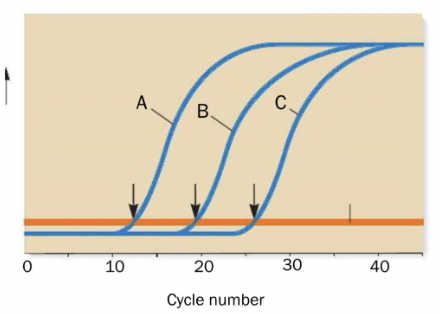
This figure shows a real-time PCR experiment carried out at low, medium, and high concentrations of starting template DNA. Please match each curve (designated by a letter) with the corresponding amount of starting template. Fluorescence values are plotted on the Y axis.
A
B
C
Medium
Low
High
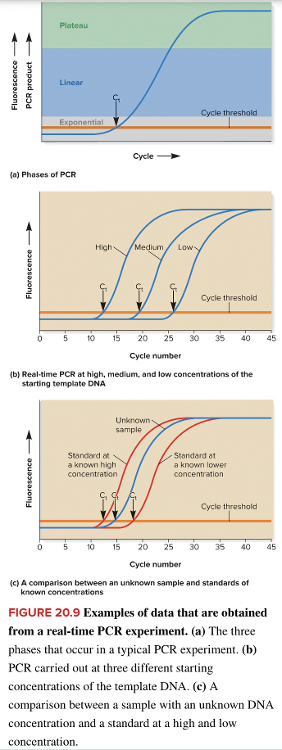
- A High
- B Medium
- C Low
Select all that apply
Select the types of standards that are commonly used in real-time PCR.
Multiple select question.
A random sequence of DNA from the sample is also amplified.
A repetitive sequence already present in the sample is also amplified.
A standard of known concentration is added to the PCR mixture.
Another gene that is already present in the sample is also amplified.
A standard of known concentration is added to the PCR mixture.
Another gene that is already present in the sample is also amplified.
Dideoxy sequencing was formulated based on scientists' knowledge of what process?
Multiple choice question.
DNA replication
Reverse transcription
Transcription
Translation
DNA replication
This technique enables researchers to determine the DNA bases in genes and other chromosomal regions.
Multiple choice question.
Southern blotting
Restriction mapping
Colony hybridization
DNA sequencing
DNA sequencing
If the oxygens on carbons 2 and 3 of the sugar of a nucleotide have been removed, the nucleotide is referred to as a
Blank 1: dideoxyribonucleotide, ddNTP, or dideoxyribonucleotides
Which scientist(s) developed an early method of DNA sequencing that involved base-specific chemical cleavage of DNA?
Multiple choice question.
Maxam and Gilbert
Kary Mullis
Monod and Jacob
Francis Crick
Maxam and Gilbert
Chain termination occurs when a dideoxyribonucleotide is incorporated into a growing DNA strand because there is no ______.
Multiple choice question.
phosphate
3'-OH group
amino
5'-OH group
3'-OH group
In automated sequencing, each dideoxyribonucleotide is labeled with a different colored ______.
Multiple choice question.
radioisotope
DNA primer
fluorescent dye
Taq polymerase
fluorescent dye
Click and drag on elements in order
Order the steps in DNA sequencing, putting the first step at the top.
High concentrations of all four unlabeled deoxyribonucleotides are added.
Low concentrations of all four fluorescently labeled dideoxyribonucleotides and DNA polymerase are added.
A laser and fluorescence detector are used to determine the color associated with each DNA strand.
Primers are added.
Many copies of a single-stranded vector containing the gene of interest are acquired.
Electrophoresis separates DNA strands according to their lengths.
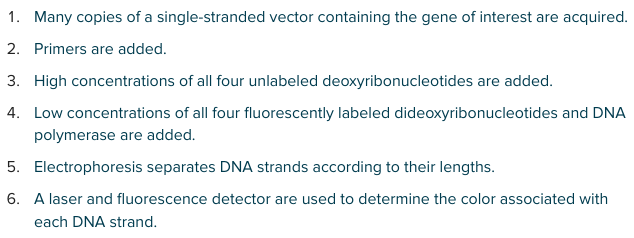
Answer in the picture.
Fill in the blank question.
The DNA sequencing method developed by Frederick Sanger that became a commonly used method of DNA sequencing is called ____ sequencing.
dideoxy
In dideoxyribonucleotides, ____ oxygens are removed from the sugar compared with ribose.
2
Sequencing using the dideoxy method results in a sequencing ladder because ______.
Multiple choice question.
using the four labeled dideoxyribonucleotides results in chain termination at each nucleotide
using the four unlabeled deoxyribonucleotides results in chain termination at each nucleotide
the amount of DNA increases in discrete steps, like a ladder
using the four labeled dideoxyribonucleotides results in chain termination at each nucleotide
Reason:
The sizes of DNA molecules, rather than the amounts of DNA, are detected by this method.
In dideoxy sequencing, if a dideoxyribonucleotide is incorporated into the growing strand of DNA, the strand can no longer grow as there is no 3' OH group. This is called ______.
Multiple choice question.
chain termination
transposition
terminal acceptance
real-time PCR
chain termination
Fill in the blank question.
____-____ ____ allows a researcher to produce a mutation at a specific sequence.
Blank 1: Site
Blank 2: Directed
Blank 3: Mutagenesis
The use of dideoxyribonucleotides with different colored fluorescent dyes allows the detection of the ______.
Multiple choice question.
appropriate vector
sequence of DNA
amount of DNA
gene of interest
sequence of DNA
Reason:
A probe is needed to detect a gene of interest.
How is site-directed mutagenesis useful in the study of genes and proteins?
Multiple choice question.
Since site-directed mutagenesis introduces random mutations, new genes can be identified.
The mutated gene can be studied in vitro only.
The mutated gene can be introduced into a living organism to see how the mutation affects the organism.
The mutated gene can be introduced into a living organism to see how the mutation affects the organism.
To ensure that the automated sequencing is accurate, it is important that the sequencing mixture contains ______.
Multiple choice question.
equal concentrations of unlabeled deoxyribonucleotides and labeled dideoxyribonucleotides
high concentrations of unlabeled deoxyribonucleotides and low concentrations of labeled dideoxyribonucleotides
high concentration of labeled dideoxyribonucleotides and low concentrations of unlabeled deoxyribonucleotides
high concentrations of unlabeled deoxyribonucleotides and low concentrations of labeled dideoxyribonucleotides
Reason:
All four types of deoxyribonucleotides are added at a high concentration and all four types of dideoxyribonucleotides (ddA, ddT, ddG, or ddC), which are fluorescently labeled, are added at a low concentration.
Dideoxy sequencing was formulated based on scientists' knowledge of what process?
Multiple choice question.
Reverse transcription
Transcription
Translation
DNA replication
DNA replication
The dideoxy sequencing method results in mixtures of DNA strands of different lengths which are run on a gel. The gel is read from the bottom up. This is referred to as a
Blank 1: sequencing or sequence
Blank 2: ladder
Site-directed mutagenesis allow a researcher to make a mutation ______.
Multiple choice question.
in the DNA flanking the gene of interest
at a specific sequence of DNA
in the vector DNA
at the ends of chromosomes
at a specific sequence of DNA
Site-directed mutagenesis is sometimes referred to as ____-directed mutagenesis.
oligonucleotide
If a scientist wanted to determine how a specific mutation in a gene of interest affected an organism, what technique would be most useful?
Multiple choice question.
Real-time PCR
Reverse transcriptase PCR
Site-directed mutagenesis
DNA sequencing
Site-directed mutagenesis
Click and drag on elements in order
Place the steps in site-directed mutagenesis in order from first to last, with the first step on top.
Design an oligonucleotide primer that is complementary to the DNA of interest, except for a mismatched region.
Add dNTPs, DNA polymerase, and DNA ligase.
Anneal the primer to the template DNA.
Introduce the DNA into a living cell.

Answer in the picture.
Which component in the CRISPR-Cas9 system makes a double-strand break in DNA?
Multiple choice question.
tracrRNA
Cas9
crRNA
Cas9
Fill in the blank question.
When the CRISPR-Cas system is used for gene mutagenesis, tracrRNA and crRNA are linked together in a molecule called the ____ ____ RNA.
Blank 1: single or s
Blank 2: guide or g
What is the most important feature of a primer used in site-directed mutagenesis?
Multiple choice question.
It contains a region that is not complementary to the template.
It comes from a natural source.
It is 20 nucleotides long.
It is exactly complementary to the template DNA.
It contains a region that is not complementary to the template.
Reason:
A mutation will not be produced if the primer is exactly complementary to the template.
How does one analyze a site-directed mutation?
Multiple choice question.
By cutting it with restriction enzymes
By sequencing it using the dideoxy method
By introducing it into a living organism
With a Southern blot
By introducing it into a living organism
Reason:
The sequence is already known, the analysis involves testing the effects of the mutation.
The natural function of the CRISPR-Cas system in bacteria is to ______.
Multiple choice question.
to make changes throughout the bacterial chromosome
to provide defense against bacteriophages
to provide defense against other bacteria
to provide defense against bacteriophages
When CRISPR-Cas is used for gene mutagenesis, what type of change does Cas9 make in the gene of interest?
Multiple choice question.
Double-strand break
Nucleotide transition
Single-strand break
Nucleotide transversion
Double-strand break
Select all that apply
When the CRISPR-Cas system is used for gene mutagenesis, which two components are combined in the single guide (sgRNA)?
Multiple select question.
Gene of interest
crRNA
Cas9
tracrRNA
crRNA
tracrRNA
Fill in the blank question.
In gene mutagenesis by CRISPR-Cas, a DNA break can be repaired by ____ end ____ or by homologous ____ ____.
Blank 1: nonhomologous
Blank 2: joining
Blank 3: recombination
Blank 4: repair
The dideoxy sequencing method results in mixtures of DNA strands of different lengths which are run on a gel. The gel is read from the bottom up. This is referred to as a
Blank 1: sequencing or sequence
Blank 2: ladder
Select all that apply
CRISPR-Cas technology has been used to mutate genes in ______.
Multiple select question.
human cell lines
human embryos
plant cells
adult mice
roundworms
mouse embryos
human cell lines
plant cells
adult mice
roundworms
mouse embryos
Reason:
While there are some recent reports of attempts to alter human genes, the outcomes have a high degree of uncertainty. The scientific community considers these attempts to be unethical.
In the CRISPR-Cas system, what part of the sgRNA is designed to be complementary to the gene to be mutated?
Multiple choice question.
Repeat region
Spacer region
tracrRNA
Linker region
Spacer region
Select all that apply
After Cas9 makes a double strand break, which characteristics are observed for repair of the break by nonhomologous end joining (NHEJ)?
Multiple select question.
The break region may incur a small deletion.
Frameshift mutation may occur in the coding sequence of the gene.
Can be used to make a specific point mutation.
Researcher includes donor DNA that is homologous to the region where the break occurs.
The break region may incur a small deletion.
Frameshift mutation may occur in the coding sequence of the gene.
What is the purpose of Northern blotting?
Multiple choice question.
To identify a specific protein within a mixture of proteins
To identify a specific DNA fragment within a mixture of DNA molecules
To identify a specific DNA molecule within a mixture of RNA molecules and proteins
To identify a specific RNA molecule within a mixture of RNA molecules
To identify a specific RNA molecule within a mixture of RNA molecules
A major advantage of CRISPR-Cas technology over site-directed mutagenesis is that it can be used directly on ____ cells.
Blank 1: living, live, or alive
Click and drag on elements in order
Place in order from first to last the steps in Northern Blotting. with the first step at the top.
Extract and purify RNA from living cells.
Load RNA onto an agarose gel.
Probe with a labeled fragment of DNA.
Blot RNAs onto a nylon membrane.
Separate RNA molecules according to size.
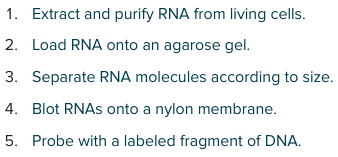
Answer in the picture.
How does one analyze a site-directed mutation?
Multiple choice question.
By cutting it with restriction enzymes
With a Southern blot
By sequencing it using the dideoxy method
By introducing it into a living organism
By introducing it into a living organism
Reason:
The sequence is already known, the analysis involves testing the effects of the mutation.
You wish to determine if a protein is made at a particular stage of development. What technique would you use?
Multiple choice question.
Southern blotting
Northern blotting
Western blotting
Polymerase chain reaction
Western blotting
This technique is used to identify a specific RNA molecule within a mixture of RNA molecules.
Multiple choice question.
Eastern blotting
Southern blotting
Northern blotting
Western blotting
Northern blotting
In the Western blot, to what is the enzyme that will give the colored reaction coupled?
Multiple choice question.
The primary antibody
The nylon membrane
The protein of interest
The secondary antibody
The secondary antibody
Reason:
The primary antibody binds to one or more proteins separated by gel electrophoresis.
What type of probe is used in Northern blotting?
Multiple choice question.
Labeled protein
Labeled antibody
Labeled RNA
Labeled DNA
Labeled DNA
For Western blotting, what type of probe is used to identify the protein of interest?
Multiple choice question.
antigen
epitope
labeled DNA
antibody
labeled RNA
antibody
What technique is used to identify a particular protein in a mixture of proteins?
Multiple choice question.
Northern blotting
Real-time PCR
Southern blotting
Western blotting
Western blotting
In the Western blot, what binds to the protein of interest?
Multiple choice question.
An oligonucleotide
The secondary antibody
An enzyme
The primary antibody
The primary antibody
Reason:
The secondary antibody binds to the primary antibody.
Antibodies bind to three-dimensional structures found within a protein that are called ______.
Multiple choice question.
receptors
domains
secondary antibodies
epitopes
epitopes
Fill in the blank question.
In the technique of Western blotting, a primary ____ binds to an ____ to identify a specific protein.
Blank 1: antibody
Blank 2: antigen or epitope
You wish to determine if a protein is made at a particular stage of development. What technique would you use?
Multiple choice question.
Northern blotting
Polymerase chain reaction
Western blotting
Southern blotting
Western blotting
After Cas9 makes a double strand break, which characteristics are observed for repair of the break by nonhomologous end joining (NHEJ)?
Multiple select question.
Can be used to make a specific point mutation.
The break region may incur a small deletion.
Frameshift mutation may occur in the coding sequence of the gene.
Researcher includes donor DNA that is homologous to the region where the break occurs.
The break region may incur a small deletion.
Frameshift mutation may occur in the coding sequence of the gene.
What technique is useful for studying protein-DNA interactions?
Multiple choice question.
Real-time PCR
Electrophoretic mobility shift assay
The construction of a DNA library
The western blot
Electrophoretic mobility shift assay
Reason:
This method identifies a protein through antibody binding.
An antigen has one or more three dimensional structures called ______ to which a(n) ______ will bind.
Multiple choice question.
antibodies; epitopes
active sites; antibody
receptors; antibody
epitopes; antibody
epitopes; antibody
For Western blotting, what type of probe is used to identify the protein of interest?
Multiple choice question.
labeled DNA
antibody
antigen
labeled RNA
epitope
antibody
How does the binding of a protein to a DNA fragment affect the ability of the fragment to migrate through a gel during electrophoresis?
Multiple choice question.
It slows the fragment's migration.
It has no effect on the fragment's migration.
It depends on the protein.
It accelerates the fragment's migration.
It slows the fragment's migration.
Which of the following techniques is used to study protein-DNA interactions?
Multiple choice question.
DNase I footprinting
The Western blot
The Northern blot
The Southern blot
DNase I footprinting
The gel retardation assay is also known as the ______.
Multiple choice question.
Southern blot
colony hybridization assay
electrophoretic mobility shift assay
Western blot
electrophoretic mobility shift assay
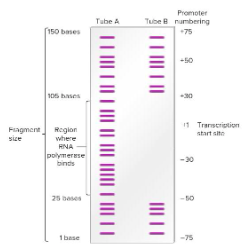
This figure shows the outcome of what type of experiment?
Multiple choice question.
Western blotting
DNA sequencing
DNase I footprinting
Real time PCR
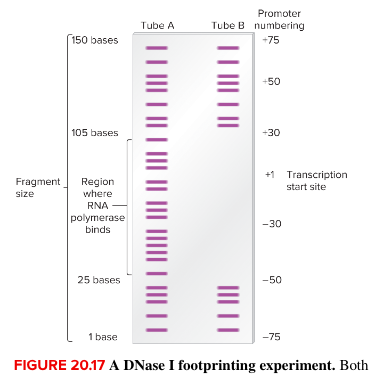
DNase I footprinting
If RNA polymerase holoenzyme is bound to the promoter of a specific gene, what will be the outcome of DNase I footprinting of this promoter region?
Multiple choice question.
The promoter will be completely digested by the DNase I enzyme.
A few sites within the promoter will be cleaved by DNase I.
The promoter will be protected from DNase I digestion.
The promoter will be protected from DNase I digestion.
The ______ assay is used to identify protein-DNA interactions because the binding of a protein to a DNA fragment slows the ability of the fragment to migrate through a gel during electrophoresis.
Multiple choice question.
Western blot
real-time PCR
dideoxyribonucleotide
electrophoretic mobility shift
electrophoretic mobility shift
The DNase I footprinting technique is used to study ____-____ interactions.
Blank 1: DNA
Blank 2: protein or binding
Which technique can identify the DNA region that interacts with a DNA-binding protein?
Multiple choice question.
DNase I footprinting
Northern blotting
Western blotting
Site-directed mutagenesis
DNase I footprinting
In a DNase I footprinting experiment, a region of DNA bound to protein will be ______ cleavage by the DNAse I enzyme.
Multiple choice question.
moderately susceptible to
highly susceptible to
protected from
protected from
How does the binding of a protein to a DNA fragment affect the ability of the fragment to migrate through a gel during electrophoresis?
Multiple choice question.
It accelerates the fragment's migration.
It depends on the protein.
It has no effect on the fragment's migration.
It slows the fragment's migration.
It slows the fragment's migration.
